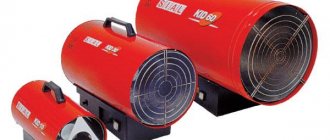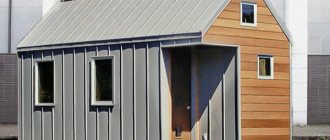Advantages and disadvantages
A potbelly stove, like any device, not just a heating one, has its own undeniable advantages, but also the same kind of disadvantages.
Positive qualities include:
- Inexpensive material for the firebox. Anything that can burn will do, from propane fuel, firewood and peat to any waste. In this case, no modifications are required to switch to another fuel.
- A DIY potbelly stove will be inexpensive compared to more expensive stoves.
- The compact size of the potbelly stove allows you to eliminate the need for a foundation and a major chimney.
The disadvantages of a potbelly stove are due to its advantages:
- Effective ventilation of the heated room is necessary.
- The design of the unit does not provide for heat accumulation, so as soon as the supply of fuel stops, the stove instantly cools down.
- High fuel consumption.
https://youtube.com/watch?v=9bm6rwog-EU
general information
Like any stove, a potbelly stove consists of an exhaust part and a heat exchange part: the first is a pipe made of metal; the second is a complex of internal elements. Today, homeowners more often use a knee chimney, and its design depends on the design features of the stove.
There is a horizontal and vertical stove. The horizontal one includes a smoke bag (chamber). It is needed to concentrate a larger volume of heat: the smoke collects in the bag, its speed decreases, and the heat is transferred into the room.
Vertical ovens are more complicated. To achieve the same effect, several curved channels are provided. They also trap smoke, which increases efficiency and has a beneficial effect on the condition of the firebox. Such a chimney makes the potbelly stove eternal.
Potbelly stove with water circuit
By upgrading an ordinary potbelly stove, you can get an original, effective source of heat in case of emergency, which will not interfere with any home.
This can be done in two ways:
- Place the water jacket on the burner pipe
- Loop several copper pipes around the outer body of the potbelly stove, thus forming a coil.
The turns of the coil tubes should be located at a distance of 5 cm from the perforated stove body and connected to the main heating system. Place a screen outside the coil to reflect the heat. It is made of tin, aluminum, galvanized steel.
Water jacket - a tank located on the top of the furnace, the body of which contains fittings (2 - water is supplied/discharged). The result is a structure similar to a samovar.
It is also advisable to install a thermometer.
Advantages of potbelly stoves and their disadvantages
Disadvantages inherent in such ovens:
- It is necessary to prevent combustion products (coals, sparks) from falling out of the firebox.
- To avoid burns (from very hot stove walls), children’s access to it should be limited.
- Heating requires a large amount of combustible materials - it is more advisable to create a stove for short-term use.
Pros of using potbelly stoves:
- The choice of solid fuel is unlimited: you can buy peat or coal, prepare firewood for it or use sawdust and wood chips, briquettes and pellets are suitable, some use machine oil (recycled) as fuel.
- It can be created with your own hands and from easily accessible raw materials.
- It has a low cost.
- It is compact - it can fit even in a cramped room, for example, you can design a potbelly stove for a garage.
- It is mobile, even when made from thick sheets of metal.
- Heating of the room when it is ignited occurs quickly.
Stove "dropper"
This stove is ideal for a small garage that does not have heating or electricity. Such an effective design can be assembled with your own hands.
It has the following advantages:
- saves fuel;
- easily moves to a new place;
- easy to use;
- It is also used for cooking.
To assemble such a unit, you will need the following materials and elements:
- metal in sheets;
- copper pipe;
- pipe branch;
- rubber hose;
- gas cylinder;
- screws;
- burner.
When constructing such a model, the following tools will be needed:
- welding machine;
- drill;
- clamp.
Work on the manufacture of this model will be safe if you place the structure in a place without drafts, away from flammable objects.
Features and principle of operation of a potbelly stove
Unlike a classic stove, a potbelly stove does not require a foundation, a complex chimney, or a platform. You can heat with wood, sawdust, wood chips, peat, coal, and used machine oil. Simple design and installation are available for DIY by people with basic metal working knowledge. Due to its small dimensions and weight, a homemade potbelly stove can easily be placed even in a small garage.
f11c6cd147659b13152568a02d83062b.jpe 00f39f8c5e29ae86bb91a48939ae3381.jpe 8f772c3fed439782b7a382d3001fa981.jpe
e8afa33b49c7a84d043b39f36a44d322.jpe
Compared to a brick stove, a potbelly stove cools down quickly. Therefore, to maintain a comfortable temperature, you will have to heat it the entire time you are in the garage. The metal becomes very hot, which can cause burns if accidentally touched.
The principle of operation of a potbelly stove is the same as that of a classic stove:
- the air necessary for fuel combustion enters the firebox through the ash pan;
- the heat generated heats the walls;
- combustion products are removed through the chimney due to natural draft;
- The rate of fuel combustion is regulated by the position of the ash door.
The principle of operation of a potbelly stove
On wood or waste oil
Depending on the size, a potbelly stove can be used to heat not only small, but also large rooms. In addition to machine oil, you can use other types of oil and diesel fuel.
The advantages of the stove during testing include:
- no need to be distracted by adding firewood, one filling lasts for a long time;
- due to 2-stage combustion, the efficiency is higher than that of its wood-burning counterpart;
- The potbelly stove does not smoke during production in any weather.
Disadvantages include:
- noise;
- when burned, the waste emits a specific odor, so ventilation is required;
- the need for frequent cleaning of the combustion chamber and chimney;
- the difficulty of removing the coked layer formed during oil combustion from the lower chamber.
The main advantage of a wood-burning stove is the ability to use any solid fuel. Disadvantages to consider:
- The efficiency is low, since a significant part of the heat flies out into the pipe;
- the need to regularly add firewood, break firebrands, and ensure that coals do not jump out of the firebox;
- time spent on fuel preparation;
- small range of regulation of the combustion process.
The characteristics of the stove during testing are better, but according to fire safety rules, the room for its installation must be equipped with supply and exhaust ventilation. Fulfilling this requirement is difficult for private owners, so they make a potbelly stove for the garage with their own hands using wood.
This is interesting: Summer gazebos - shapes and designs
Potbelly stove from an old barrel
The main advantage of installing such a firebox is its simplicity. For such a design, they usually make a single door for both chambers (firebox, ash pan). Since the surface of the barrel is convex, iron fittings or a plate are welded on top to install flat-bottomed containers, for example, for cooking. Such a potbelly stove in the garage has more disadvantages than positive aspects. First, the door must always be ajar to ensure a constant supply of oxygen. This may result in combustion products entering the garage. Secondly, the low heat capacity and the complexity of welding work are caused by thin metal. It is better to install such a potbelly stove outdoors, since it is a fire hazard and takes up a lot of space.
Potbelly stove from an old barrel
Making a potbelly stove from an iron can has similar disadvantages. The only significant advantage is the presence of a door. Holes are made in the bottom of the can, exactly in a row, into which iron fittings are inserted. Thus, the container is divided into two compartments. In such a potbelly stove it is quite difficult to control the air supply. All that remains is to weld the supporting legs. This design is more compact, but is also not safe, like the previous one.
Step-by-step instructions for making a stove
Step 1. In our example, we use a simple 250-liter barrel with thick walls - ideal for making a stove. Cut off the top of the barrel, but do not throw it away.
The top of the barrel has been cut off
Step 2. Make a kind of lid from the top - a “pancake” for oxygen supply. Adjust it to the size of the barrel - as a result, when installed, there should be 2 mm between it and the walls around the entire circumference. Weld the neck of the lid. In its center, make a hole to install a pipe through which air will be supplied. Also weld 4 channels, as in the photo below.
“Pancake” for air supplyAnother photo of the element
Step 3. Stepping back a little from the top edge, cut another hole in the barrel wall for installing a chimney. In our example, the chimney will be a pipe with a diameter of 140 mm.
Hole for chimney installation
Step 4. Start making the lid. Make it from sheet metal 4 mm thick, and weld a sealing ring at the bottom corresponding to the diameter of the barrel. In the center of the lid, make a hole for the pipe that was welded to the “pancake”.
Cover for the ovenIn the middle of the cover there is a hole for the air duct from the “pancake”
Step 5. Make simple legs at the bottom of the barrel to make the structure stable. The legs must be metal, as well as all other elements.
Making legs for the stoveThe legs must be metal
Step 6. Install the stove in the desired location and begin creating the chimney. In our example, it is of a prefabricated type. First of all, make a clamp with which the chimney will be attached to the body.
A clamp that will allow you to attach the chimney to the stove
Step 7. Make guides in the chimney, thanks to which it can be easily fixed to the body.
Guides in the chimney
Step 8. Join the barrel with the pipe, making sure to lay all the joints with asbestos fabric. Place a clamp over the fabric and tighten it.
Asbestos fabricTightening the clamp over the fabricThe finished joint between the pipe and the barrel
Step 9. That's it, the structure is assembled, you can check its functionality. Load sawdust or firewood inside.
The stove is loaded with fuel
Step 10: Add used oil to the fuel, then install the cap. As for the “pancake”, don’t use it yet. After the fuel ignites, remove the lid and place the “pancake”. To fully warm up such a structure, it takes about 10 minutes; in the future, the firewood will burn for a long time. Although exactly how long the combustion will last largely depends on the quality of the fuel.
Photo of the finished stove for the garage
Video - Homemade potbelly stove for the garage
If you wish, you can modify the design described above, although it will already cope with its functions perfectly. For example, to increase efficiency, you can increase the surface area and thereby improve heat transfer. For this purpose, weld metal plates on the sides of the body.
In addition, you can make a grate with an ash pan: cut a circle from a sheet of metal along the inner diameter of the body, drill holes with a diameter of 60-80 cm and install from below. After this, the ash will be poured down through the holes - to where the ash pan is equipped. It is believed that this will cause the fuel to burn faster, remember this point and make sure that the ash pan is sealed as much as possible.
How to make a potbelly stove in the garage
For most people, the word “garage” is simply associated with a box for storing a car. However, there is a fairly large category of car owners for whom the garage is truly a “second home.” They are ready to spend all their free time there - fortunately, there will probably always be work here. In addition, garages have rightly acquired a strong reputation as a kind of “men’s club”, where the uninitiated, especially women, are not recommended to enter.
How to make a potbelly stove in the garage
But it’s just that winter is trying to make adjustments to the active life of the garage - it’s extremely uncomfortable to work in a frozen room, and just chatting with friends is very uncomfortable. However, inventive craftsmen always find a way out - they install homemade stoves, constructing them themselves or using the advice of their comrades on how to make a potbelly stove for the garage.
Let us also make our contribution to this noble men's cause. The publication will discuss several ways to make a potbelly stove with your own hands.
Wood stoves made from scrap materials
The basic design of the simplest potbelly stove operating on solid fuel is very simple. In essence, it is a thick-walled metal container divided into two main compartments.
Firewood or other fuel is placed in the upper firebox, for which a loading door must be provided. The grate separates the firebox from the lower compartment, which is much smaller in size - the ash pan, which also often plays the role of a blower. It is also recommended to install an appropriate door through which the potbelly stove is regularly cleaned of ash. In addition, opening the door a certain width regulates the flow of air into the combustion chamber, and therefore the intensity of firewood combustion. A pipe is welded into the upper combustion chamber to drain combustion products into the chimney pipe.
Such a scheme gives scope for independent design of simple potbelly stoves, and a wide variety of materials or used items and devices are used as blanks. There is probably no need to teach real masters how to cook a potbelly stove for a garage - it’s probably better to just give a number of interesting ideas that can be taken as a basis and supplemented with your own modifications, based on existing capabilities and preferences.
1. One of the simplest options is a potbelly stove made from an old metal barrel.
The design shown in the figure is simplified to the extreme. The master manufacturer decided to abandon the two separate doors, combining them into one common one. A metal frame is welded on top of the barrel, allowing you to lay a metal sheet on it, which becomes a kind of “hob” - you can, for example, heat water on it.
Potbelly stove made from a barrel - a simple design, but with a lot of disadvantages
The advantage of such a design is, perhaps, only one - simplicity and speed of production, accessible to almost everyone. There are many more disadvantages.
- Firstly, the barrel itself is not the best option for a potbelly stove - the walls are thin, their heat capacity is low, and they will not last long - they will quickly burn out.
- Secondly, it is quite difficult to regulate the intensity of combustion.
- Thirdly, the design is bulky and takes up a lot of space. You can, of course, think about a vertical arrangement, but this still will not eliminate the main problem - the thinness of the walls
- And, fourthly, such a potbelly stove is very unsafe in terms of fire safety.
It is better to have such a stove not in the garage, but somewhere on the street, for waste disposal.
2. Something similar, with the same main disadvantages, but more compact, can be made from a standard 40-liter can.
The simplest design from a standard metal can
The scale of work, including welding, is even smaller here. In fact, only the legs (3) and the chimney pipe (2) are welded to the body (1). The door is already ready - it remains standard, only two rows of holes (4) are drilled in it for air access. A homemade grate made of a metal rod is placed inside, conditionally dividing the can into two compartments - and the mini-potbelly stove is ready.
3. The use of old gas cylinders provides very wide opportunities in the manufacture of garage stoves. These vessels have thick, greasy walls that can be easily welded and themselves have a good heat capacity.
The main difficulty is to properly prepare the cylinder for further work, since even with the neck removed, vapors in an explosive concentration may remain in it. You may come across advice to fill the container with water overnight, and then, after draining the liquid, start cutting it. However, as practice shows, this does not provide a complete guarantee of work safety. In this light, the following approach seems optimal:
- Bury the vertically placed cylinder in the ground so that it is securely fixed for cutting with a grinder.
- Fill it with water right up to the neck and let it sit for 2-3 hours.
- Draw a line around the circumference to mark the future cut.
- Start cutting along the marked line until a through hole appears. water will begin to flow out. You must wait until its level drops to the cutting level, and then carefully continue working with the grinder and remove the cover completely.
- Now you can drain the water and continue further work - the cylinder will no longer pose any danger.
There are a lot of options for potbelly stoves made from cylinders.
— It is often made horizontally. The cylinder capacity itself is, in fact, a finished combustion chamber. Dividing it into two in this orientation is irrational; it is better to make it from sheet metal and weld a box-shaped ash pan with its own door on the bottom.
An ash pan box is welded to the bottom of the cylinder
In this case, the grate can be rows of holes drilled in the cylinder body:
The role of the grate can be performed by rows of drilled holes
If you find a real cast-iron grate of the appropriate size, then you can do it differently - cut a window in the wall of the cylinder that will ensure a tight fit of this part:
Another option is a window for installing a regular cast iron grate
You can make the firebox door yourself, using a fragment cut out for the firebox window, or you can weld a finished part, which can be purchased at a hardware store:
You can make the door yourself or use a standard one
The structure is installed on welded pipes or leg corners at a height convenient for use. A pipe for connection to the chimney is cut into the rear part.
— In order to save garage space, the cylinder can be placed vertically. In this case, it is divided into two chambers, with brackets welded inside, onto which a homemade round grate made of a steel rod with a diameter of 10 - 12 mm is placed. Two doors are made - a firebox and a blower.
The upper cut part can be covered with a metal sheet - in this case, a kind of cooking surface will appear. Another option is to purchase a cast iron cauldron of the required diameter, which will fit exactly as a “plug” and turn into a container for heating water or even for preparing a variety of dishes.
An original solution - instead of a top lid, a well-fitted cauldron is used
To allow combustion products to exit from the rear, a standard 90-degree outlet with a diameter of 100 or 110 mm is welded in, and then the vertical part of the chimney is connected to it.
Another craftsman offers an original design. As a finished part for the potbelly stove, he used an air tank-receiver from the brake system of a truck.
The master did not install ordinary doors. For the blower, a pipe is welded in, equipped with an adjustable damper that limits the flow of air. There is also no loading hatch on the side wall of the potbelly stove - it uses the principle of top loading of solid fuel. The top cover is hinged and equipped with an arched handle for convenience.
Hinged top lid of the potbelly stove with top loading of firewood
The internal space of the cylinder into the firebox and ash pan is divided by a homemade grate:
The space is conventionally divided into two compartments by a homemade grate
The design itself is simple to manufacture, but during operation it requires caution when adding firewood. In addition, the process of cleaning such a potbelly stove from accumulated ash will also not be entirely convenient.
Potbelly stoves of a similar design can also be made from scraps of thick-walled pipes with a diameter of 300 - 500 mm.
4. Steel sheet is an excellent material; a potbelly stove can be made from it with your own hands, drawings of which are easy to find on the Internet.
As an example, you can give a drawing of an efficient solid fuel stove, which will require sheet metal with a thickness of at least 4 mm (thinner walls will simply burn out quickly).
Drawing for self-production of a potbelly stove for a garage made of steel sheet
The drawing below shows all the dimensions, and it will be easy for any craftsman to cut in the parts necessary for the work. The main “highlight” of this design is the presence of two partitions (1). They create a kind of labyrinth for the release of combustion products, which do not immediately fly away into the chimney, but provide maximum heat transfer from the potbelly stove.
A metal plate (2) with rows of drilled holes with a diameter of 12 - 15 mm is used as a grate.
It is advisable to “dress” the potbelly stove in a metal casing using sheet metal 2 mm thick. The plates (3) are cut to the dimensions of the side and rear walls and attached to the stove body either on threaded posts or using 50 mm long bushings (4).
Such an addition to the design of the potbelly stove will solve three problems at once:
- The likelihood of accidental burns from the hot walls of the stove will be reduced.
- The impact of hard infrared radiation from it, which is not always pleasant and necessary, will be reduced.
- The resulting gap of 50 mm between the walls of the potbelly stove and the screens will create a powerful convection flow of heated air, thanks to which the garage will be quickly and evenly heated.
These are not all possible options for solid fuel garage stoves. Other interesting designs and detailed technology for their manufacture can be found on other pages of our portal dedicated to this issue.
Video: homemade stove for a garage made of sheet metal
Now, it probably makes sense to take a closer look at the design of the stove, which uses as fuel such a common, almost “waste” material in garages as used motor oil.
How to make a potbelly stove during mining
In fact, having a supply of firewood in the garage to fire a potbelly stove is not always convenient. But work is almost always available or it’s easy to find. This becomes especially true in large garage cooperatives, where they often install special containers for draining old oil, or in auto repair shops. So why not take advantage of the opportunity to use virtually free fuel for heating?
The design of such stoves and their layout can also be very diverse - from compact potbelly stoves designed for a small room to large and bulky devices with high heat transfer, capable of heating large areas.
Mining stoves can be quite large in size
However, the operating principle and basic design elements are similar for all of them. They consist of two containers. The lower one is intended for filling with used oil - there it is superficially ignited and brought to a boil. Oil vapor rises up through a pipe that is perforated for oxygen access. Here the process of afterburning the rising vapors begins, and their final oxidation and combustion takes place in the upper chamber, which is already connected to the chimney system.
The photograph clearly shows the main heating zones of the stove during mining
If you look at a photograph of a stove-stove working in exhaustion, then the temperature distribution in this heating device is very clearly visible from the intensity of the infrared radiation spots. The lower container with oil does not heat up much: the light spot is only a visible area of an open flame on the surface of the burning oil. The main afterburning begins in the upper third of the vertical perforated pipe, and the temperature reaches its peak values in the upper chamber - even its thick-walled body literally becomes red hot. It is this part of the potbelly stove that provides maximum heat exchange with the air in the room.
It is necessary to know the operating principle of such a stove. This will help you correctly determine the materials necessary for its manufacture - obviously, the most heat-resistant parts should be the parts of the vertical pipe and the upper chamber.
Below are drawings of a do-it-yourself potbelly stove that works according to this scheme. Almost all dimensions are indicated in them, but still, in order to manufacture such a heating device, it is necessary to give a number of explanations by examining this process in more detail.
Basic drawing for making a potbelly stove for mining
So, the work on making such a stove begins with the selection of materials. First of all, you need to have two pieces of pipe for the housings of the lower and upper chambers (items 2 and 8). The drawing indicates a diameter of 352 mm and 344 mm, but such a standard simply does not exist. Is it easier to change the data a little and apply pipe trimmings 355.6? 6 or 325? 6 mm.
The work begins with the selection of the necessary parts and materials
The thickness of the steel sheets used for the manufacture of other parts is 4 mm, with the exception of the top cover (item 10) and partition (item 9), which require metal 6 mm thick.
Layout of the main components of the stove
For a vertical chamber, a pipe with a diameter of 100 mm with a wall thickness of at least 4 - 5 mm is used. The same pipe will be required for the chimney pipe.
The process can begin with the manufacture of the lower chamber. To do this, a bottom cut around the circumference (item 1) is welded to a piece of 355 mm pipe with a height of 115 mm (item 2). All seams in the stove structure must be absolutely sealed.
Walls and bottom of the lower chamber
The top of this container must be removable. This means that it is necessary to have a cylinder (item 3) that would fit tightly, almost without a gap, onto the lower one. It will not be possible to select it according to standard pipe sizes, which means you will have to make it yourself. A metal strip 60 mm wide is cut, which, by heating with a gas burner and using clamps, is bent around the body of the lower container, and then welded with a vertical seam.
Making a ring for the removable cover of the lower chamber
Now, using the resulting ring, you can accurately measure and cut out the cover for it (item 4). Two holes are immediately cut out on it - a central one, Ø 100 mm (item 4.1) for welding in a vertical perforated pipe, and one offset towards the bottom, Ø 60 mm - it will be used for refueling, ignition and adjusting the flow of primary air for oil combustion. A sliding cover (pos. 4.3) is being prepared, which will be secured in the hole (pos. 4.4) using a rivet or bolt (pos. 4.5).
A lid with holes is welded to the prepared ring
Then the finished lid is welded to the ring.
Pipe section 100? 5 mm long 360 mm is marked for drilling holes in it. The top row should be 55 mm from the edge, the bottom row should be 20 mm. It is necessary to place 6 rows of 8 holes each evenly, so that they are staggered. The diameter of the holes is 9 mm. Both ends of the pipe are immediately chamfered for further welding during the assembly process.
The next step is to install the upper chamber. To begin with, prepare two covers that have the same dimensions, but differ in metal thickness - the bottom (item 7) is 4 mm, and the top (item 10) is 6 mm. A hole Ø 100 mm is cut in each of them - as shown in the drawing. The diameter of these covers must, of course, exactly match the diameter of the thick-walled pipe used, from which a 100 mm high cylinder is cut (item 8).
It is immediately necessary to prepare a jumper (item 9), which will serve for more complete combustion of rising vapors, preventing them from quickly escaping into the chimney pipe, thereby creating an additional afterburning chamber.
Assembly begins by welding the upper, thicker cover to the cylinder.
Aligning the top cover with the cylinder walls
After the sealed seam has been completed, a jumper is installed with its maximum displacement towards the smoke outlet, and welded on three sides.
Installing a jumper in the upper chamber
Now you can weld the bottom cover. Its hole should be located strictly diametrically to the upper one.
Very accurately checking the square, achieving perpendicularity in all planes, install, grab, and then weld the perforated pipe to the bottom cover.
The perforated pipe must be strictly perpendicular to the bottom cover
Then you can weld the chimney pipe (pos. 11) to the corresponding hole in the top cover.
Welded chimney pipe
At the opposite end of the perforated pipe, also maintaining perpendicularity, weld the lid of the lower fuel tank.
Welding the fuel tank cap to a perforated pipe
To ensure that the collapsible part of the lower container does not warp, as well as to prevent “parasitic” air suction, it is recommended to provide a sealing lip. It can be made by bending a steel rod around the circumference of the cylinder at the junction of the upper and lower parts.
Making a sealing band
This O-ring is then welded to the bottom of the "pan".
... and its fixation to the walls of the “pan”
In fact, all that remains is to weld the legs (item 6) and the stove can be considered ready. For greater stability of the stove, you can weld a stand (III in the diagram), which will add rigidity to the structure.
The finished potbelly stove in disassembled condition. The reinforcing strut is clearly visible
If desired, after cleaning, you can coat it with heat-resistant paint and safely use it.
The stove can be coated with heat-resistant paint
You can refill it through the neck of the lower container, but this can be done safely only when the previously filled oil has completely burned out. To avoid such inconveniences during operation, it is recommended to supplement such a potbelly stove during testing with another “option” - a device for monitoring the oil level in the combustion chamber and safe refueling during operation.
To do this, you will have to make another open container, approximately the same height as the lower “pan”. The shape of this vessel is not particularly important. Both of these containers will be located on a common stand made of two parallel metal corners.
Both containers are welded to the guides - corners...
Holes of the same diameter are cut in the bottom of both containers and connected by a curved tube.
... and connected by a tube
So, we got two communicating vessels. According to the laws of physics, the liquid level in both is always the same. Thus, the owner of the stove always sees the level of waste oil remaining in the combustion chamber and can, without any problems, replenish the fuel supply by pouring it into an open container.
True, in order to ensure greater safety, it is better to also provide a protective screen that will cover the open vessel from direct thermal radiation of the combustion chamber.
For greater safety, it is recommended to mount a protective screen made of sheet metal
Now we can say with complete confidence that the potbelly stove is ready for testing. All that remains is to install it in place, connect it to the chimney pipe, fill it with fuel and carry out a test ignition.
Ignition of the finished stove during testing
For ignition, liquid for fireplaces (stoves) is usually used; I pour about 100 ml on top of the oil into the filler neck. A lit wick and a rag or paper soaked in the same liquid are lowered there. Surface combustion should begin, which in a few minutes will lead to boiling of the oil, the formation of vapors and the transition of the entire potbelly stove to its “normal” operating mode - this is usually accompanied by a characteristic hum.
In the model under consideration, ready-made parts were used - cuttings of thick-walled pipes. If they could not be found, then quite the same stove can be made from a steel sheet, with box-shaped refueling and afterburning chambers, simply observing certain proportions of their volume in relation to the parallelepiped. The efficiency of the stove will not suffer at all from this. The thickness of the material used is the same, 4 and 6 mm.
Video: stove in operation with box-type chambers
What should those garage owners do who already have a conventional stove that runs on solid fuel, but are interested in the possibility of using waste oil as fuel? It's okay - and there is an acceptable way out for them. You can make a special “attachment” that will make the potbelly stove universal.
This “attachment” can turn an ordinary potbelly stove into one that runs on waste oil.
In fact, this is the lower capacity of the stove for exhaust, also with a perforated pipe, but only bent at an angle of 90 degrees (by welding a standard outlet).
She's from a different angle
But instead of a final combustion chamber, an ordinary wood-burning stove is used, into which this curved pipe is connected using an adaptation device. For example, in a regular potbelly stove, the firebox door can be made removable and replaceable. One, the usual one, will be installed when using firewood, and the other, which has a corresponding hole for inserting a pipe, will be installed when using the “attachment” during mining.
In this case, a round plug with a hole for the pipe inlet is used as an “adapter”. The standard firebox door is simply folded to the side
Another option is to weld the pipe on the side, in the stack of the potbelly stove - then the stove will turn out to be universal. You just have to provide a damper so that when using firewood, the flame does not spread and the ash from the firebox does not fall into the perforated pipe and container with oil.
Advantages and disadvantages of potbelly stoves during development
To ensure that the operation of a potbelly stove during mining does not cause much trouble, you need to know its features, advantages and disadvantages, which must be taken into account when using it.
The advantages include the following qualities:
- The stove is unpretentious and does not require intervention in its operation - the main thing is to correctly adjust the air gap on the filler neck (usually 10 - 15 mm). It has good heat dissipation and can quickly heat a closed room.
- When used correctly, such a potbelly stove does not smoke and no fumes are released from the chimney pipe.
- The furnace, to a certain extent, can be considered fireproof in the sense that the fuel (exhaust) itself never burns under normal conditions, and only the afterburning of the vapors it produces occurs in the chamber.
However, such a scheme has many disadvantages:
- We have already mentioned the noisy operation of the stove. In addition, you cannot get rid of the characteristic smell. However, for garage conditions this should not matter much. Sometimes masters find another solution to a similar problem. For example, an additional air heat exchanger is installed on the upper chamber, through which air is driven using a fan to heat the adjacent room.
An air heat exchanger connected to a fan is added to the design. The flow of hot air heats the adjacent room
- Both the combustion chamber (perforated pipe) and the chimney quickly become overgrown with deposits of combustion products and require frequent preventative cleaning.
- Burning oil in the lower chamber always leaves a coked layer, which is quite difficult to clean.
Video: stove in operation with a water heat exchanger
During the operation of the stove, a number of mandatory rules must be observed:
- The use of waste oil with flammable impurities, such as gasoline, is not allowed. The waste must be filtered so that it does not contain suspended solids.
- Working with water is also dangerous - this can lead to boiling of the liquid and splashing of the oil, possibly igniting it. Collection of waste for further use as fuel must be carried out under conditions that prevent the ingress of water.
- Under no circumstances should such a stove be placed in a strong draft - this may cause the flame to spread to surrounding objects. There should never be any flammable substances or materials around the stove. Reliable thermal insulation of the walls of the room must be provided.
- The room must have reliable ventilation, since the operation of the stove is associated with intense absorption of air oxygen and the release of carbon monoxide, which is dangerous to health and life.
- It is strictly forbidden to use any other flammable liquids as fuel - this may result in an explosion in the upper chamber or chimney pipe.
- You should never leave such a potbelly stove unattended. It is strictly forbidden to go to bed in a room with a working stove. Before leaving, you should make sure that the oil has completely burned out and that the process of burning off its vapors has ended.
- It is forbidden to pour water on the stove to cool it, or use water to extinguish the fire - this will only aggravate the dangerous situation.
- The stove chimney should not have horizontal sections. An inclined section is allowed to change direction at an angle of 45 degrees. The minimum length of the chimney pipe should be 4 m, and the recommended length is from 5 to 7 m.
- The recommended fill level when initially filling the stove is up to? volume of the lower container.
- When using such a stove in a garage, there must be a powder fire extinguisher or a box of sand near it.
So, probably anyone who has solid welding and plumbing skills can make a potbelly stove for the garage. It is enough to show your imagination or use the drawings of ready-made designs - and everything should work out. The main thing, both in the manufacture and in the operation of such stoves, is to constantly observe basic safety measures so that the heating device does not cause a big disaster.
Making a potbelly stove with your own hands
When making a stove for your dacha yourself, you practically cannot do without:
- electric or gas welding machine;
- an angle grinder (“grinder”) with cutting and grinding wheels;
- a set of manual plumbing materials (calipers, ruler, hammer, drill, pliers, metal scissors, chisel, etc.).
The following materials are used to make a potbelly stove with your own hands:
- sheet metal with a thickness of at least 3 mm (because thinner metal will warp due to high temperature, or it will quickly burn out);
- housings of household gas cylinders (namely household ones, because industrial cylinders are too narrow for this purpose);
- metal barrels for fuels and lubricants (100 l, 200 l);
- metal rod (for the grate, all kinds of handles);
Pipes and elbows for potbelly stoves are usually made of tin. It is advisable to order their production from a master tinsmith, or purchase industrially manufactured ones at a hardware store.
The potbelly stove set consists of:
- from the stove itself;
- composite chimney;
- from a set of pipes and elbows;
- damper (damper assembly for the chimney);
- cutting (the junction of the chimney through the window of the room or the awning of the tent);
- a metal scoop, a poker, a metal sheet and a box for solid fuel, which are necessary for servicing the stove.
Potbelly stoves made of steel sheet
Potbelly stoves made of steel sheet
If a car enthusiast has a good imagination, then if you have suitable metal sheets, you can make potbelly stoves of any design. The first step is to make a drawing of the potbelly stove. The standard solution is to make a rectangular stove with two doors and separate combustion and ash receiving chambers with a grate. You can make two holes on the top. The legs are made at a height convenient for the owner. Some craftsmen make the top cover removable, so that the potbelly stove can easily be turned into a barbecue. Such potbelly stoves are often scalded with a metal sheet, keeping a small space between the wall and the sheet to protect yourself from accidental burns.
Option #1 - reliable and efficient brick
Brick ovens are not often found in garages, since this option is quite labor-intensive. Such a device occupies a small area, approximately 2x2.5 bricks. For masonry, refractory bricks are taken, and a solution of sand, refractory clay and fireclay powder is mixed.
When making a brick oven for a garage, a special fireclay brick is used, and when mixing the solution, it is recommended to add fireclay powder
For the combustion chamber, fireclay bricks are used at the level of the second, third and fourth rows of brickwork. The height of such a brick kiln is usually nine bricks. To remove furnace gases, a brick chimney is installed into which a stainless steel sleeve is inserted. The chimney is usually brought out through the roof.
Beginning builders who decide to build a brick stove in the garage should discuss the nuances of the project with an experienced stove maker - after all, this is a whole science worthy of its own profession. If significant flaws are made during the work, the masonry will have to be destroyed and completely redone.
Types and materials for manufacturing
To build furnaces of this type yourself, there is no need to purchase specialized parts or manufacture individual particles. Sometimes even improvised materials are suitable for work, which can be bought at a very low cost or even received for free. But some requirements for metals and brick products used for the construction of the structure are absolutely justified.
Let's take a closer look at all the types of designs and the intricacies of manufacturing certain models.
Potbelly stove
Perhaps the most common option for a garage stove is a potbelly stove. Such models were popular at the beginning of the 20th century and, being easy to use and very practical, were able to practically replace fireplaces. Potbelly stoves were popular in houses and apartments until the advent of central heating, and after that they began to be used only when necessary.
A potbelly stove is a very economical product, since its production does not require any large expenses. For manufacturing, you can use, for example, propane cylinders or large iron pipes with dense walls, which must have considerable strength.
Iron barrels are also quite suitable, but their choice should be given special attention. The barrel should not be too large, since a stove with too large dimensions will be bulky and not entirely practical, but it should have fairly thick walls - from 2 to 5 mm
There are types of potbelly stoves with a water circuit, which are slightly different from the classic models. Heating of this structure is carried out by increasing the temperature of the water, as well as the evaporation of a certain amount of it, so the walls remain hot longer and radiate heat for a much longer time, heating the room.
The duration of heat distribution is the main advantage of this model, since the distribution and maintenance of heat can be enough even to heat a small country house. As for a small garage space, for those who spend most of their time working on the car, this is an excellent heating design option.
Brick structures
In addition to compact and easy-to-use potbelly stoves, there is also a variant of brick structures, which has a number of both advantages and disadvantages.
This model retains heat much longer because it needs a longer time to cool down. This heat capacity is ensured both due to the thermoregulatory properties of the brick and due to the rather large weight of the structure as a whole.
For a brick model, it is necessary to have a damper, which is also called a blower, thanks to which you can regulate the temperature in the room. The main thing is to learn how to use such functions of this model, since improper use of the damper can even harm your health.
When making a brick oven yourself, you can save a lot of money, since the material is quite inexpensive, and the process is not so labor-intensive as to involve third-party labor. The main thing is to calculate the required amount of brick and cement, as well as purchase the necessary cast iron parts.
The heating power directly depends on the size of the firebox, therefore, depending on the functional features of the room itself, you can make a suitable size heating structure with the appropriate power.
But, unfortunately, this product also has some disadvantages that can slightly overshadow the process of using the stove.
This design takes a long time to cool down, but it also heats up for quite a long time, so some problems may arise with quickly warming up the room. In addition, in order to maintain a certain temperature in the room, it is necessary to light the stove daily.
Installation features
To install the stove you will need the following items:
- Chimney opening protection;
- elbow 160 × 1200 mm2 (2 pcs.) and 100 × 1200 mm2;
- three elbows for joining elements;
- tee.
In some cases, it is necessary to insulate the chimney using special heat-resistant products. Experts also provide a visor to protect the hole, and to seal the seams they use a special compound, the main characteristic of which is the optimal operating temperature. As an alternative to sealant, asbestos cord is used.
A potbelly stove is an excellent alternative to other stoves; its chimney is installed with your own hands according to the following principle. A small piece of pipe is fixed to the nozzle. The elbow is extended to the floor slab. A hole is cut in it with a diameter of at least 160 mm. It is important to comply with fire safety rules, therefore, if there is thermal insulation material at the point where the chimney passes, it is removed. This eliminates the possibility of it igniting.
Before passing the pipe through the ceiling, a pass-through glass is installed. Next, the structure is docked with the outer part of the smoke exhaust system. To achieve greater tightness, a thin layer of bitumen is applied to the outer part of the chimney, the pipe is wrapped in a special heat-resistant material (this could be, for example, mineral wool), and in order to prevent debris and dirt from entering the pipe, a fungus is installed.
The potbelly stove is ready, the garage will be warm, and the car will not freeze. The final stage is to test the oven. It needs to be warmed up well, to see how the components behave. If there are no problems, then the design will last a long time, the main thing is to monitor the stove, prevent any possible fire hazard, maintain the firebox (clean from burning, check the chimney, etc.).
Reliable and fast
It is very simple to build a smoke exhaust system for a potbelly stove; you just need to arm yourself with a small supply of tools, metal and dexterity. The garage can be heated without fear of fire, the stove has been tested by time, back in the 20th century it was recognized as the best alternative to foreign fireplaces. The potbelly stove is also attractive because its design is simple, but the room warms up very quickly.
- Coaxial chimney of a gas boiler: device and installation
- Installing a chimney in a wooden house: rules and features
- Ceramic chimney: DIY installation
- How to build a brick chimney
Operation technology
When using a potbelly stove, you should follow important rules:
- maintain a safe distance between the stove and the walls;
- the chimney should only be taken outside;
- the place where the pipe goes outside is covered with solutions;
- It is recommended to place a box of sand and hang a fire extinguisher next to the device.
These recommendations will extend the life of the stove and improve safety.
Safe installation of the heating device
It is extremely important to follow fire safety rules when installing a potbelly stove. The best place is the far corner of the room, opposite the gate
The chimney is led only to the street.
If the garage walls are made of wood, then the stove is installed at some distance. The wall itself near the device is covered with a metal sheet or concreted. It would be correct to attach a metal sheet at the base of the stove.
6e162aebc95ce3c564df48f7a0fbfc69.jpe
a7d0d3647671b60020d0593c1475a9b9.jpe
Preparation of heating material
A popular fuel for potbelly stoves is wood. They need to be thoroughly dried and sawn. The size of the firewood should be approximately 25 cm. Store the firewood in a dry, ventilated area, protected from precipitation. Oak, birch, apple, and cherry warm up the room well. Do not use spruce or pine. They produce little heat and produce a lot of soot during combustion.
Cleaning the oven
The stove should be cleaned periodically to prevent dirt and soot from accumulating in the chimney. For the work, purchase a special chimney brush. But you can make the device yourself. A brush with stiff bristles is attached to the end of the stick:
- Before starting work, cover the opening in the firebox with a rag.
- Initially, make several movements in the chimney.
- Then they take out all the accumulated garbage.
All actions are carried out carefully so as not to damage the surface of the structure.
How to improve draft in a potbelly stove using fuel
Only an oven that is not filled to the brim can ensure sufficient air circulation. Determining the sufficient amount of fuel can be done as follows:
- Prepare a standard size bucket and put fuel in it.
- Place a small portion in the firebox and light it.
- Continue adding fuel until the beginning of the hog - a horizontal chimney for removing gases - takes on a cherry tint. This volume will be minimal.
- Add fuel and watch the far part of the hog - 1/5 of it should remain dark. This figure will be the maximum.
Video: instructions for increasing the efficiency of a potbelly stove
Thus, with fairly simple actions that do not require costs, you can increase the efficiency of the potbelly stove and extend the service life of its individual parts.










